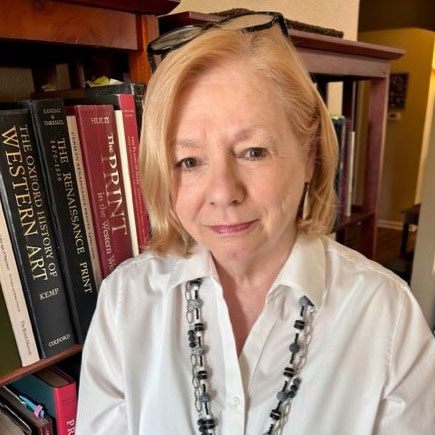Born in 1949, Linda grew up in the Indianapolis area. At Lawrence Central High School, a wonderful art teacher encouraged her artistic interests, which she pursued at Indiana University in Bloomington, earning a BA in art history and comparative religion in 1971. After a summer spent in Washington DC as an intern at the National Gallery of Art, she entered the graduate program in art history at the University of North Carolina in Chapel Hill, where she earned a PhD with a specialization in Renaissance and Baroque art in 1978. Influenced by her classes and graduate seminars, she chose to focus on northern European art in the early modern period. She wrote her dissertation on Hans Baldung Grien and his relationship to Albrecht Dürer.
Between 1976 and 1986, she held teaching positions at the University of Tennessee in Chattanooga, Northern Illinois University in DeKalb, and the University of Tulsa. In 1987, she was hired as an assistant professor at the College of Wooster. She not only taught a variety of courses in the Art and Art History Department, but she also contributed to the Women’s Studies (now WGSS) Program, which greatly enhanced and enriched her existing interest in feminism and how feminist theory could be applied to art history. Eventually, she would serve as a Coordinator of WGSS as well as a Chair of the Art and Art History Department.
Gender issues in art would remain the central theme of her publications, although she is also known for The Print in the Western World: An Introductory History (University of Wisconsin Press, 1996). In Tulsa she had been assigned to teach the history of prints and she realized the need for such a college textbook. At Wooster, she was able to use that book in her History of Prints course, in which she also made use of the College’s extensive print collection in exhibitions researched by herself and her students. During her teaching career, Linda also served as President of the Midwest Art History Society and as a board member of the College Art Association, participating frequently in their conferences with papers and as a panel chair.
Linda’s longstanding interest in images of witches began with her dissertation on Baldung and resulted in articles and essays, and finally, The Witch as Muse: Art, Gender, and Power in Early Modern Europe (University of Pennsylvania Press, 2005). Wooster’s leave policy and travel funding during her twenty-four years at the College aided her research and publication. More recently, before and after her retirement in 2011, Linda turned to the growing field of masculinity studies and its relevance to art. This has already resulted in two articles and an essay in an anthology, and she hopes to carry this topic further. She now lives in her hometown with her husband Bill Munger, a music programmer and announcer for classical, jazz, and folk radio. They met in DeKalb and married in Tulsa in 1983.
- The Witch as Muse: Art, Gender, and Power in Early Modern Europe. Feminist study of witchcraft images, their historical contexts, and their embodiment of the art-theoretical concepts of invention and fantasy (Philadelphia: The University of Pennsylvania Press, 2005).
- The Print in the Western World: An Introductory History, 900-page scholarly introduction to the history of prints, ca. 1400-1980 (Madison: University of Wisconsin Press, 1996).
- Current project, “Seeing Satan,” in The Routledge History of the Devil in The Western Tradition, ed. Michelle Brock, Richard Raiswell, and David Winter (forthcoming in 2024). The essay discusses images of Satan from the Early Christian period through the nineteenth century.

